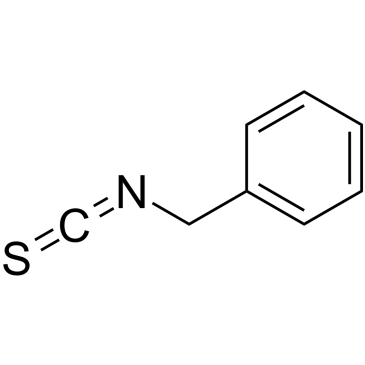a-Isothiocyanatotoluene

a-Isothiocyanatotoluene structure
|
Common Name | a-Isothiocyanatotoluene | ||
|---|---|---|---|---|
| CAS Number | 622-78-6 | Molecular Weight | 149.213 | |
| Density | 1.0±0.1 g/cm3 | Boiling Point | 243.8±9.0 °C at 760 mmHg | |
| Molecular Formula | C8H7NS | Melting Point | 41 °C | |
| MSDS | Chinese USA | Flash Point | 100.4±26.5 °C | |
| Symbol |


GHS07, GHS08 |
Signal Word | Danger | |
|
In vitro metabolic conversion of the organic breakdown products of glucosinolate to goitrogenic thiocyanate anion.
J. Sci. Food Agric. 95 , 2244-51, (2015) Glucosinolates are abundant in Brassicaceae vegetables, and they are degraded into various organic breakdown products (BPs) (R-CN, -NCS and -SCN) by myrosinase when plant tissues are damaged. This study was designed to investigate whether these BPs could be b... |
|
|
Cytochrome p450 enzymes mechanism based inhibitors: common sub-structures and reactivity.
Curr. Drug Metab. 6 , 413-54, (2005) The inhibition of human cytochrome P450s (CYPs) is one of the most common mechanisms which can lead to drug-drug interactions. The inhibition of CYPs can be reversible (competitive or non-competitive) or irreversible. Irreversible inhibition usually derives f... |
|
|
Transient receptor potential ankyrin 1 (TRPA1) channel as emerging target for novel analgesics and anti-inflammatory agents.
J. Med. Chem. 53 , 5085-107, (2010)
|
|
|
Study of the chemical reduction of the fumonisins toxicity using allyl, benzyl and phenyl isothiocyanate in model solution and in food products.
Toxicon 63 , 137-46, (2013) Fumonisins (FBs) are bioactive compounds produced by several strains of Fusarium spp. which contain a polyketide structure similar to sphinganine. These mycotoxins contain a free amino group that could work as an electron donor and react with the electrophile... |
|
|
Analogues of morphanthridine and the tear gas dibenz[b,f][1,4]oxazepine (CR) as extremely potent activators of the human transient receptor potential ankyrin 1 (TRPA1) channel.
J. Med. Chem. 53 , 7011-20, (2010) The TRPA1 channel can be considered as a key biological sensor to irritant chemicals. In this paper, the discovery of 11H-dibenz[b,e]azepines (morphanthridines) and dibenz[b,f][1,4]oxazepines is described as extremely potent agonists of the TRPA1 receptor. Th... |
|
|
Proteomic analysis of covalent modifications of tubulins by isothiocyanates.
J. Nutr. 142(7) , 1377S-81S, (2012) Although isothiocyanates (ITC), which are found in cruciferous vegetables, have been shown to inhibit carcinogenesis in animal models and induce apoptosis and cell cycle arrest in tumor cells, the biochemical mechanisms of cell growth inhibition by these comp... |
|
|
Development and application of a method for identification of isothiocyanate-targeted molecules in colon cancer cells.
Anal. Biochem. 429(2) , 124-31, (2012) In this study, we have developed a novel method to identify isothiocyanate (ITC)-targeted molecules using two well-studied ITCs: benzyl ITC (BITC) and phenethyl ITC (PEITC). The principle of this method is based on identifying a pattern of differences between... |
|
|
Bioactive maca (Lepidium meyenii) alkamides are a result of traditional Andean postharvest drying practices.
Phytochemistry 116 , 138-48, (2015) Maca, Lepidium meyenii Walpers (Brassicaceae), is an annual herbaceous plant native to the high plateaus of the Peruvian central Andes. Its underground storage hypocotyls have been a traditional medicinal agent and dietary staple since pre-Columbian times. Re... |
|
|
Chemo-predictive assay for targeting cancer stem-like cells in patients affected by brain tumors.
PLoS ONE 9(8) , e105710, (2014) Administration of ineffective anticancer therapy is associated with unnecessary toxicity and development of resistant clones. Cancer stem-like cells (CSLCs) resist chemotherapy, thereby causing relapse of the disease. Thus, development of a test that identifi... |
|
|
Benzyl isothiocyanate suppresses high-fat diet-stimulated mammary tumor progression via the alteration of tumor microenvironments in obesity-resistant BALB/c mice.
Mol. Carcinog. 54(1) , 72-82, (2015) We previously reported that a high-fat diet (HFD) and M2-macrophages induce changes in tumor microenvironments and stimulate tumor growth and metastasis of 4T1 mammary cancer cells in BALB/c mice. In this study, we attempted to determine whether benzyl isothi... |